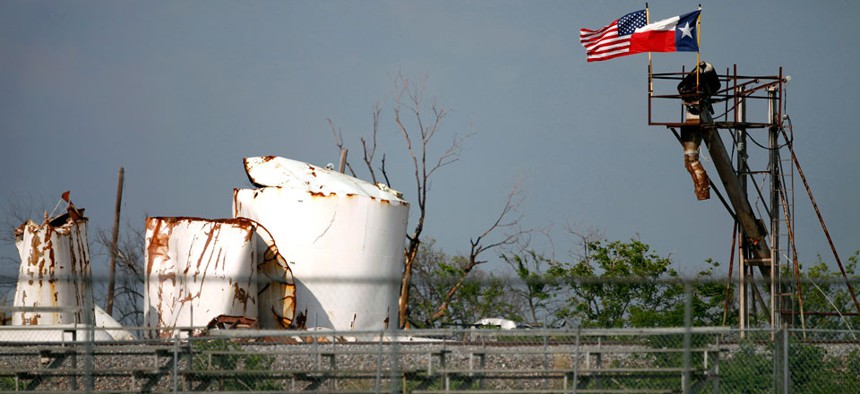Reliance on Industry May Have Led to Texas Oversight Lapse, Official Says
DHS has 'doubled down' since fertilizer plant explosion killed 14.
A reliance on industry to provide information about facilities that handle dangerous chemicals might have contributed to the Homeland Security Department’s failure to regulate the site of a major explosion in Texas earlier this year, a DHS official suggested Wednesday.
“It is absolutely a shared responsibility,” David Wulf, director of the department’s infrastructure security compliance division, told Global Security Newswire. “Facilities that are in the business of dealing with … high-risk chemicals … have an obligation to do that reporting, just as I have an obligation to file our taxes with the IRS.
“The IRS doesn’t necessarily come out and look for us,” he added. “At the same time, we’re committed to doing all we can to get word out” that these reporting requirements exist, he said.
During formal remarks at a chemical-sector security conference, Wulf said DHS officials have “a pretty high degree of certainty that we have reached facilities that are members of the national trade associations” and informed them of their responsibility to comply with federal Chemical Facility Anti-Terrorism Standards, which require companies to submit site security plans if they handle a significant amount of dangerous chemicals.
He noted, however, that it appears that the West, Texas, fertilizer plant that exploded in April -- killing 14 and leveling nearby homes and businesses –--was not a member of such a trade group.
Since the incident, Wulf said, the department has “doubled down” on its efforts to reach facilities that qualify for regulation. It recently exchanged lists of known facilities with state agencies in Texas in an effort to identify sites known to the state but not to the federal department and vice versa. DHS officials have also renewed efforts to compare notes about relevant facilities with other federal agencies involved with chemical-safety regulation, such as the Environmental Protection Agency, Wulf said.
The Homeland Security Department had previously attempted such information sharing with the EPA Risk Management Program several years ago when the CFATS program was just getting under way, according to Wulf. The initial effort was largely unsuccessful due to technical differences between the two agencies’ databases. However, this time around, the department has launched a more advanced information-technology program aimed making the exchange more useful.
The move appears aimed at addressing concerns that the Texas facility was not on the Homeland Security Department’s radar, even though other regulatory agencies were aware the facility had been handling significant quantities of dangerous chemicals.
A risk-management plan filed with the Environmental Protection Agency said the facility possessed up to 54,000 pounds of toxic anhydrous ammonia -- more than five times the CFATS threshold of 10,000 pounds. In addition, the plant last year reported to the Texas State Health Services Department that it possessed 270 tons of explosive ammonium nitrate -- more than 1,000 times the CFATS reporting threshold of 400 pounds.
On Thursday, Joan O'Hara, deputy chief counsel to the House Homeland Security Committee, told conference attendees the panel would host a hearing to further examine why the DHS program has not reached certain "outlier" facilities such as the Texas plant.
The West, Texas, incident has been the focus of the latest criticism directed at the DHS program. Prior to the incident, the initiative had faced more than a year’s worth of congressional scrutiny pertaining to a leaked internal memo that revealed a litany of management problems, including a failure to conduct onsite inspections and approve facility security plans.
On Wednesday, Wulf, who co-authored the memo, sought to portray the CFATS program as one that had “turned a corner.” He noted that as of last July, the program had given preliminary approval to only 50 site-security plans, conducted only 10 inspections and had not granted final approval to a single site-security plan since it was first authorized by Congress in 2007. One year later, the department has provided preliminary approval for “upwards of 500” site-security plans, has conducted more than 50 inspections and has granted final approval for 160 site-security plans.
The program has also completed 90 of 95 “action items” that the internal memo had identified as needed to get the program back on track, Wulf said.
Labor and environmental groups argue, however, that even if it runs smoothly, the DHS program lacks the legal teeth needed to ensure that domestic chemical security is adequate. They note that the law authorizing the program does not allow the department to require any specific security improvements and argue that the Environmental Protection Agency should use its own authorities under the Clean Air Act to craft more stringent rules.
In recent weeks, Senator Barbara Boxer (D-Calif.) has also pushed for stronger EPA action on chemical security. Boxer, who has oversight authority over the agency as chairwoman of the Senate Environment and Public Works Committee, has offered harsh criticism over what she says is an inadequate response to the Texas tragedy.
Republicans and major industry groups have long opposed further EPA involvement in the chemical security arena, arguing that the agency’s existing regulations -- along with those of the Homeland Security Department, Occupational Health and Safety Administration and various state agencies -- are sufficient.




